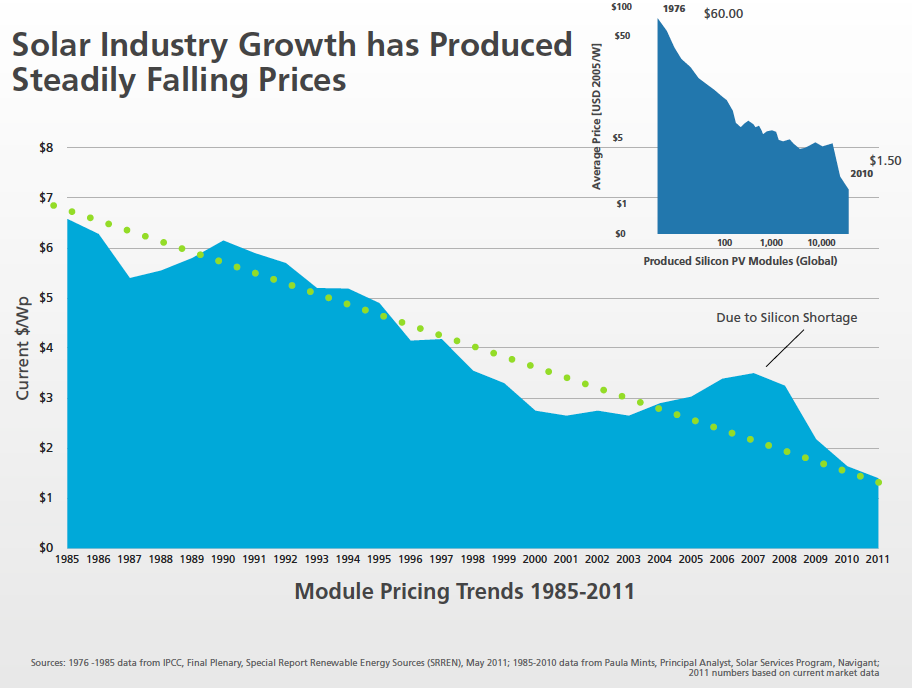Cross-posted from Climate Progress.
Nobel Prize-winning economist Paul Krugman had another good column in The New York Times yesterday, “Here Comes the Sun.” He makes three key points. First, solar is rapidly coming down the cost curve — I’ve sprinkled a couple of the Climate Progress charts on this throughout this post. Second, fracking is overhyped. Third, the only thing that can stop the solar revolution in this country is fossil-fuel-driven politics:
We are, or at least we should be, on the cusp of an energy transformation, driven by the rapidly falling cost of solar power. That’s right, solar power. If that surprises you, if you still think of solar power as some kind of hippie fantasy, blame our fossilized political system, in which fossil fuel producers have both powerful political allies and a powerful propaganda machine that denigrates alternatives …
These days, mention solar power and you’ll probably hear cries of “Solyndra!” Republicans have tried to make the failed solar panel company both a symbol of government waste — although claims of a major scandal are nonsense — and a stick with which to beat renewable energy.
And don’t forget the traditional media, who overhype the output of that propaganda machine.
But the cost drops are real and impressive:
But Solyndra’s failure was actually caused by technological success: The price of solar panels is dropping fast, and Solyndra couldn’t keep up with the competition. In fact, progress in solar panels has been so dramatic and sustained that, as a blog post at Scientific American put it, “there’s now frequent talk of a ‘Moore’s law’ in solar energy,” with prices adjusted for inflation falling around 7 percent a year.
This has already led to rapid growth in solar installations, but even more change may be just around the corner. If the downward trend continues — and if anything it seems to be accelerating — we’re just a few years from the point at which electricity from solar panels becomes cheaper than electricity generated by burning coal.
And if we priced coal-fired power right, taking into account the huge health and other costs it imposes, it’s likely that we would already have passed that tipping point.
See this post on the American Economic Review report that took those costs into account.

I see on his blog that Krugman is getting a little blowback:
I’ve been getting some pushback from people I respect on today’s column, not so much for what I actually said as for what they fear readers may take away from it. So a bit of clarification.
Some of it involves questioning the cost data, but the main point, I think, is that even if solar power’s price per kWh matches coal-fired, it’s not going to take over the market right away, and maybe not ever. The sun doesn’t shine at night, and often doesn’t shine during the day. Intermittency is a big problem, and I probably should have made that clearer.
So what we’re actually looking at is still a partial role for solar, as a piece of a multi-source energy system. The point, however, is that it’s now looking like a much larger part than anyone imagined — and if we priced coal-fired power properly, that transformation would be happening now.
Well, the thing to remember is that for many, if not most, applications, solar competes with retail prices, not the far lower wholesale prices. Solar panels are hooked up on a roof and plug directly into the grid — avoiding all of that expensive and difficult transmission and distribution:
That’s a key reason why demand has been soaring:
Yes, this isn’t equivalent to baseload generation — but of course peak power is considerably more valuable than baseload.
Krugman also takes on fracking:
Fracking — injecting high-pressure fluid into rocks deep underground, inducing the release of fossil fuels — is an impressive technology. But it’s also a technology that imposes large costs on the public. We know that it produces toxic (and radioactive) wastewater that contaminates drinking water; there is reason to suspect, despite industry denials, that it also contaminates groundwater; and the heavy trucking required for fracking inflicts major damage on roads.
Economics 101 tells us that an industry imposing large costs on third parties should be required to “internalize” those costs — that is, to pay for the damage it inflicts, treating that damage as a cost of production. Fracking might still be worth doing given those costs. But no industry should be held harmless from its impacts on the environment and the nation’s infrastructure.
Yet what the industry and its defenders demand is, of course, precisely that it be let off the hook for the damage it causes. Why? Because we need that energy! For example, the industry-backed organization energyfromshale.org declares that “there are only two sides in the debate: those who want our oil and natural resources developed in a safe and responsible way; and those who don’t want our oil and natural gas resources developed at all.”
So it’s worth pointing out that special treatment for fracking makes a mockery of free-market principles. Pro-fracking politicians claim to be against subsidies, yet letting an industry impose costs without paying compensation is in effect a huge subsidy. They say they oppose having the government “pick winners,” yet they demand special treatment for this industry precisely because they claim it will be a winner.
Indeed. And for those who are concerned about catastrophic climate change, natural gas is even more problematic.
Krugman’s bottom line is inarguable:
But will our political system delay the energy transformation now within reach?
Let’s face it: a large part of our political class, including essentially the entire G.O.P., is deeply invested in an energy sector dominated by fossil fuels, and actively hostile to alternatives. This political class will do everything it can to ensure subsidies for the extraction and use of fossil fuels, directly with taxpayers’ money and indirectly by letting the industry off the hook for environmental costs, while ridiculing technologies like solar.
So what you need to know is that nothing you hear from these people is true. Fracking is not a dream come true; solar is now cost-effective. Here comes the sun, if we’re willing to let it in.



